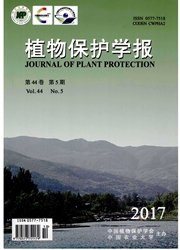

 中文摘要:
中文摘要:
为探讨桂枝主要活性物质肉桂醛和肉桂酸对新余蜜橘青霉病的抗性及其机理,以500倍和1 000倍咪鲜胺稀释液为阳性对照,蜜橘损伤接种后,测定了防护效果最佳时肉桂醛、肉桂酸的抑菌浓度,分析了对果实活体防效和防御酶活性的影响。结果表明,25、8 mg/m L肉桂醛以及30、15mg/m L肉桂酸是最佳抑菌浓度;与对照组相比,各浓度药液处理均能显著降低病原菌的致病力,贮藏第6天,25、8 mg/m L肉桂醛处理组的病情指数分别为54.4%和66.4%,30、15 mg/m L肉桂酸处理组分别为49.6%和63.2%;各浓度药液处理均能降低新余蜜橘的MDA和H_2O_2含量,显著提高并维持SOD、PPO等防御酶的活性,以25 mg/m L肉桂醛和30 mg/m L肉桂酸处理效果最佳。研究表明,肉桂醛和肉桂酸能有效增强果实活体防护效果以及诱导果实的抗病性,且抗性的产生可能与果实内相关防御酶活性提高有关。
 英文摘要:
英文摘要:
In order to explore the effects and mechanisms of the main active ingredients of Ramulus cinnamomi cinnamaldehyde and cinnamic acid on Xinyu tangerine blue mould disease-resistance,the protective effects of cinnamaldehyde and cinnamic acid at suitable antifungal concentrations and their effects on defense-related enzymes were analyzed,with 500,1 000 times diluted prochloraz as the control. The results showed that 25,8 mg / m L cinnamaldehyde and 30,15 mg / m L cinnamic acid were the most suitable antifungal concentrations in all treatments. Cinnamaldehyde and cinnamic acid at different concentrations significantly decreased the pathogenicity compared with the control. The disease index of fruits treated with 25,8 mg / m L cinnamaldehyde were 54. 4% and 66. 4%,respectively,after six days,and the disease index of fruits treated with 30,15 mg / m L cinnamic acid were 49. 6% and63. 2%. Cinnamaldehyde and cinnamic acid could decrease the contents of MDA and H2O2,and significantly improve the activities of SOD and PPO,and 25 mg / m L cinnamaldehyde and 30 mg / m L cinnamic acid were the optimal concentrations in all treatments. The results indicated thatcinnamaldehyde and cinnamic acid could effectively increase the preservation effects,and induce fruit disease resistance to the blue mould,which were related to the activity increase of defense enzymes.
 同期刊论文项目
同期刊论文项目
 同项目期刊论文
同项目期刊论文
 期刊信息
期刊信息
